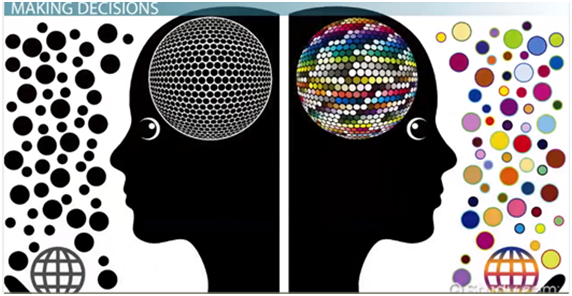A Coaching Power Tool By Anita Szabo, Leadership & Career Coach, HUNGARY
The Shades Black & White vs. Critical Thinking

The shades between black and white are not grey. They are the full-color spectrum!
‘Black and White’s thinking is one of the most common challenges I see with coaching clients. The issue with Black-and-White thinking is that it limits the ocean full of possibilities, options, and ideas to just two possible choices. Yet this is very limiting. Clients might feel they must make either/or choices; however, they can explore the endless possibilities that lie in between.
Amongst many cases, I experienced black-and-white thinking when I went through significant changes in my life; changing the country where we live, quitting a well-paying and highly respected job after a decade, and transitioning into coaching. Despite how much I expected to have a career break and enjoy the free time for energizing learning, I felt scared of not having the same steady flow of income anymore.
I was sure that I did not want to have a full-time job requiring the same amount of time and resources and that building up a coaching business requires more time to be created. Before taking this topic to peer-coaching, I felt stuck with the idea that either taking another full-time job that would impact my work-life balance the same way as my previous position or fully dedicating myself to business building, compromising my cash flow for several months. Coaching helped me to discover that my thinking was limited in several aspects. Not all jobs are the same, and there can be ways to do both for a certain amount of time.
Definition of Black-and-White Thinking
Black-and-white thinking is a thought pattern that makes someone think or feel in absolutes. Something is either right or wrong, good or bad, success or failure; there is no in-between; however, the world generally does not work in such a “one or the other” way. It often comes together with perfectionism, usually recognizing just two levels of performance: perfection and failure.
Peoplewithblack-and-white thinking sees things in very simplistic ways, often seeing only the two extremes:
- Best/Worst
- Success/Failure
- True/False
- Right/Wrong
- Us/Them
- Rich/Poor
- Winners/Losers
As Isaac Asimov, the famous biochemistry professor highlighted the relativity of wrong: “The basic trouble, you see, is that people think that “right” and “wrong” are absolute; that everything that isn’t perfectly and completely right is totally and equally wrong.”
When Black-and-White thinkers believe in something, they believe it 100% and have absolutely no doubts that they are right. They not only THINK they are right, they KNOW they are right, and anyone who disagrees with them must be absolutely wrong. They usually do not allow different perspectives, middle ground, or other opinions. As they feel massive certainty, and they also have strong emotions. They are not just ANGRY but FURIOUS. They do not just DISLIKEs someone but HATE them. They are not simply UPSET, but they are DISGUSTED.
Although Black-and-White thinking can sometimes be helpful, it can force us to make decisions when we have been procrastinating, and it can help us to ‘chunk up’ and find clarity in complicated situations.
Possible limitations for the clients:
- Losing essential details and limiting themselves
- Failing to see linkages and complexities
- Taking their perspective as the only reasonable one
- Lack of flexibility, seeing their facts as only relevant ones
- The constant need for absolute answers and certainty.
- Feel like having only two sub-optimal choices
The Difference between Black & White vs. Critical Thinking
Definition of Critical Thinking
Many people perceive critical thinking as a negative thing. There is a massive difference between critical thinking and negativity. Negative thinking assumes that only bad things will happen without concrete evidence or proof. Critical thinking is looking at every detail and then deciding on your own way. In other words, finding the truth and not accepting any belief or claim.
Critical thinking is the ability to engage in reflective and independent thinking. It comes with analyzing all available facts, observations, arguments, and evidence to form a judgment. It is self-guided, self-disciplined thinking which attempts to store at the highest level of quality in a fair-minded way. In essence, critical thinking requires clients to use their ability to reason. It strives to be an active learner rather than a passive recipient of any information.
Critical thinkers attentively question ideas and assumptions rather than just accepting them. They will always seek to determine whether the ideas, arguments, and findings represent the whole picture and are open to identifying that they do not.
Possible benefits of critical thinking:
- Constantly attempting to live rationally, reasonably, empathically
- Approaching problems consistently and systematically rather than by intuition
- Accepting new ideas or explanations is easier because it explains the evidence better
- Ability to consider a variety of possible perspectives
- Avoid thinking simplistically about complicated issues.
- Understanding links between ideas and complexities
- Identifying inconsistencies in reasoning
- Relying on reason rather than emotion
- Recognizing the need to develop as thinkers and commit themselves to life-long learning and self-improvement
- Making better decisions based on a range of possibilities considering the impact
- Recognizing emotional impulses, selfish drivers, or other ways of self-deception
Benefit from the Shift toward black & white vs. Critical Thinking
How clients can benefit from the shift toward critical thinking:
- Become truly honest with themselves.
- Accepting that their beliefs about the past and present may not be based on reality.
- Empathize with how others may think or feel.
- Become aware of their limited thinking and that it often does not serve them well.
- Understanding that others who disagree with them do not necessarily have negative intentions.
- Improving in decision-making with the ability to change their mind if there is new information
- Boosting their creativity
- Enhancing problem-solving ability
- Saving time by not staying “stuck” with only two options
Potential signs of black & white thinking:
- Oversimplified understandings of both other people and the self.
- Believing that all conditions must be 100% perfect to complete a task
- Being the best or worst with no in-between
- One option prevents another option, such as “I could do X, but then I can’t do why.”
- Frequently using a lot of absolute type words, i.e.: always, can’t, never, everyone, awful, definitely, etc.
Questions to help the client to realize their current limited thinking:
- What evidence is there to support your answer?
- If you keep on doing what you’ve always done, you will keep getting what you’ve always gotten. What do you think?
- What if you had no choice?
- What if there is no perfect option?
- What makes you think having no other options?
- How does that make you feel when someone does not agree with you?
- Is holding your current perspective really helping you in this situation?
- What specifically is happening to you that is causing you to react in this particular manner in this situation?
- What is the worst thing that can happen if you choose X or Y?
- Can you see letting go of this point of view?
- What are you afraid of that is holding you back from making the decision?
- What might you be missing? What’s hidden?
- What else could you consider?
Question the coach may ask to help the client shift from “black-and-white” to critical thinking and help them to find additional options:
- What is the other way to look at this challenge?
- What would happen if there were more options?
- What other possibilities/ideas are there that you haven’t thought of yet?
- Think of someone you truly respect and admire. How might they look differently at your situation? What suggestions would they have?
- If you were stuck forever with X or Y (their black-and-white options), what ideas do you have about how you could make your situation better/easier?
- What is it that you really want?
- Suppose for a moment that you have all the money/ support/ time/ energy/ confidence/ health you need. What other options/ways are there of looking at this?
- What steps can you take to achieve your desired goal?
Importance of Critical Thinking in Leadership and Career Coaching
According to the Globe Economic Forum, critical thinking is one of the most desired skills to have within the workforce, as critical thinkers are solving problems in a more creative way, analyzing information better, planning systematically, and thinking outside the box. Critical thinkers make the most effective choices, meaning also being better in decision-making.
Critical thinking can facilitate understanding themselves better, avoiding their limiting beliefs, and focusing on their strengths. Being in reality with themselves and having an in-depth understanding of why they think the way they think. Critical thinking can allow them to understand the angle of others better, becoming more open-minded towards other views, which is even more important when leading teams.
References
Emma-Louise “Why Black and White Thinking May Be Keeping Keep Your Clients Stuck?” The Coaching Tools Company, February 17, 2022
Camille Harris “Can Black and White’s Thinkers Change?”, Lamountain & Associates
Reina Gattuso: “5 Ways Black and White Thinking Poisons Your Perspective”, Talkspace, July 31, 2018.
“Black or White Thinking”, Coach Mar
Maria Bonita “Can Critical Thinking Be Negative?”, Learn from Blogs
“Defining Critical Thinking”, the Foundation for Critical Thinking
“Critical Thinking Skills”, Skills You Need
“12 Personal Benefits of Critical Thinking You Must Know”, Cushy Value

/iPEC%20Coaching/iStock-1372029359.jpg#keepProtocol)
/iStock-1395144844_blog.jpg#keepProtocol)

